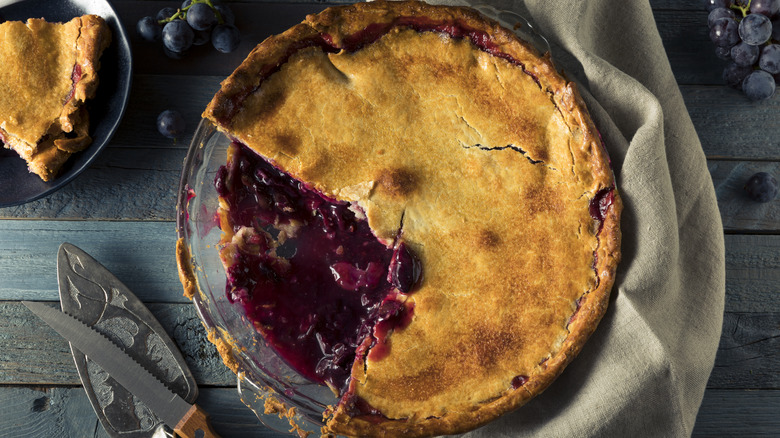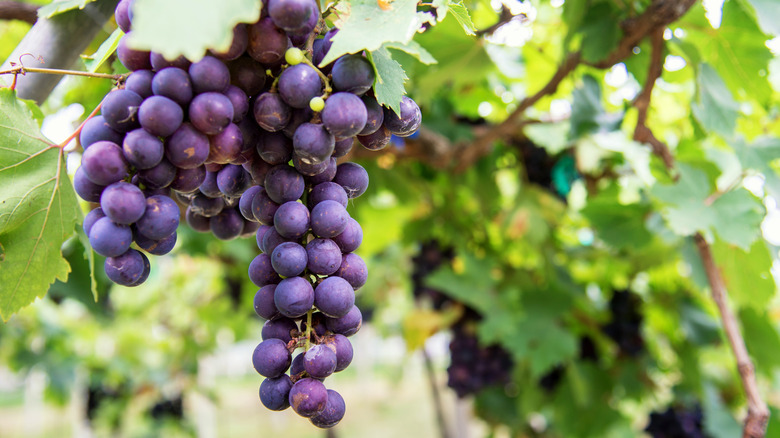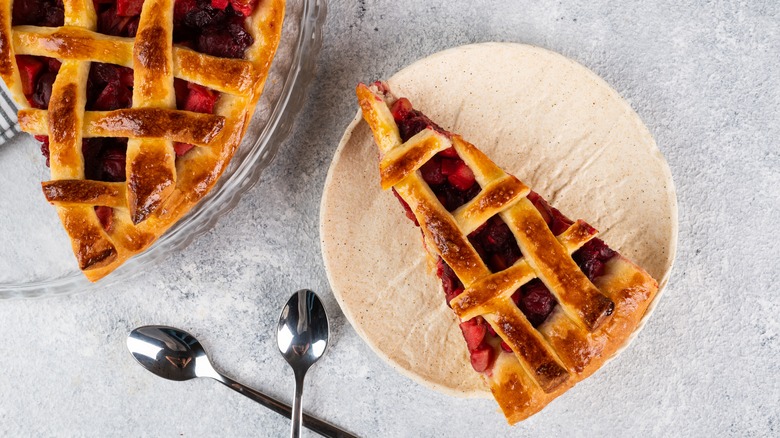When It Comes To Fruit Pies, Don't Sleep On Grapes
Some berries will come immediately to mind when the topic of pies comes up — the lattice-topped blueberry pie, the tart cherry pie, or the sweet and summery strawberry pie, just to name a few. There is one berry, though, whose pie potential shouldn't be ignored: grapes. So often found in salads or eaten on their own as a snack — grapes are juicy, fresh, sweet, and delicious when baked. Like the fruit itself, the grape pie is a palatable blend of sweet and tart with a wine-like intensity.
If you haven't heard of grape pie before, you shouldn't be too surprised. Raisin pie dates back to the 1800s when the Pennsylvania Dutch would serve it after funerals, but grape pie is a relatively recent invention. Most popular in the Concord grape-growing region of New York, its genesis can be traced back to the 1950s in Naples, New York, where the pie was invented by a local, Irene Bouchard. It's now a mainstay dish in the area, with the annual Naples Grape Festival selling around 20,000 grape pies every year.
Choose your variety wisely
Traditionally, the pies have been made during Concords' harvest season, late summer to early fall, but if you freeze fresh grapes or search around for the right variety, the pie can be enjoyed all year long. Concord grapes are the preferred (and original) variety for this pie and what you'll see listed in most recipes. They're sweet and tangy — but even if you've never had a Concord grape on its own, you're probably familiar with the flavor. Most "grape-flavored" foods taste like Concords, rather than like the grapes you'd usually buy in the grocery store.
Speaking of grocery store grapes, the Thompson seedless variety typically found in the produce section can also be used for grape pie. If you're looking for more of a Southern flare, opt for muscadine grapes instead. Varieties like Concord and muscadine have thick skins that typically become soft when baked and add just a little texture, so whether or not you remove the skins before baking is up to you. Both Concord and muscadine grapes are slip skin, which means that the pulp will slip out easily when pushed. Seeds are more challenging to remove, so you can choose seedless varieties — but seeded grapes often have more flavor, so the extra removal steps may offer a taste benefit.
The resulting taste will vary some, depending on the variety — Concords are sweet, muscadines are musky, Thompson seedless are tart. Whichever you choose, your grape pie will be juicy and jammy, with a texture similar to blueberry pie.
Try something new
Now that you've mastered grape pie, you might be on the hunt for more unique pie filling ideas to wow your friends at the next potluck. You won't be searching for long — although the search for the ingredients might take a little longer, depending on where you live. Get your hands on some Saskatoon berries, a slightly nutty, antioxidant-rich fruit that's also called a serviceberry, to make a Saskatoon berry pie. This Canadian comfort food is a favorite in parts of Canada and the northern U.S. plains, where the berries are native. Not overly sugary, Saskatoon berries make for a pie filling with just the right amount of sweetness.
It's not just berries that can be stars of the pie show, though. If you're up for a challenge and not intimidated by spiky exteriors, a prickly pear pie is a dramatic dessert choice with its vibrant color and unusual flavor. The cactus fruit is a bright mauve and hot pink inside, deepening to a dark purple when baked. The taste is a little tart, sometimes compared to melons or kiwi and even to bubblegum. Widen your filling horizons and your pie game can reach new heights.


